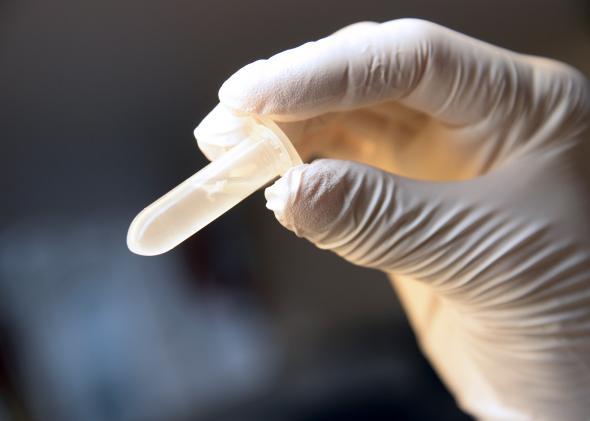Four years ago, I invited a group of strangers off the Internet to do an experiment no one outside a lab had ever done. An artist, a biologist, a writer, and half a dozen others gathered in my living room to genetically engineer bacteria to glow green. The experiment itself was not novel. The gene we manipulated had been used in labs for 20 years (and eventually won its discoverers the Nobel Prize in chemistry in 2008). What made the experiment new, and therefore edgy, was the setting—a Brooklyn apartment, rather than an institutional biology lab.
Until that moment, academic and industrial labs held the monopoly on DNA sciences. Our experiment and the ones that soon followed spread biotechnology beyond institutional walls and into homes, garages, and shared labs. The movement to bring biotech to the public became known as Do-It-Yourself Biology, or DIYbio, and now has 4,000 members on its online message board. According to a survey I published with the Woodrow Wilson Center this week more people joined DIYbio this year than the five previous years combined.
Some see the upswell of DIYbio as the fulfillment physicist Freeman Dyson’s prediction in the New York Review of Books “that the domestication of biotechnology will dominate our lives during the next fifty years at least as much as the domestication of computers has dominated our lives during the previous fifty years.”
“The final step in the domestication of biotechnology will be biotech games,” he wrote in 2007, “played with real eggs and seeds rather than with images on a screen. … The winner could be the kid whose seed grows the prickliest cactus, or the kid whose egg hatches the cutest dinosaur.”
News articles on DIYbio starkly contrast Dyson optimistic vision. They have often painted DIYers as menacing, wielding the technology as magic, without acknowledging the actual difficulty of doing laboratory bioscience.
The Atlantic, for example, predicted that three years from now nameless “biohackers” might customize a lethal virus to target the American president in a feature ominously called “Hacking the President’s DNA.” Even the New York Times raised the specter of amateurs concocting the next flu pandemic. In his latest book, biotechnologist J. Craig Venter, famous for his role in deciphering the human genome, warned about “the fallout that could occur as a result of DNA manipulation by a non-scientifically trained biohacker or ‘biopunk.’ ”
These portraits—both positive and negative—hinge on visions of the technology’s potential rather than the reality of what so-called biohackers are actually doing. So far, practitioners have reverse-engineered basic lab equipment. They’ve sequenced DNA found in the environment and in themselves. They’ve built toys that control the movements of microorganisms, such as paramecium or slime mold. In fact, Dyson had it backward: The “domestication of biotechnology” has begun with toys and games, and may one day lead to transformative applications.
DIYers are a long way from engineering pandemics, which is only possible in sophisticated biolabs, or customizing viral assassins, which is only possible in science fiction. So far, fewer than half of the DIYers I surveyed have done any genetic engineering, despite the fact that inserting a gene into bacteria is one of the first techniques learned in molecular biology labs. Using personal computing as an analogy, this would be the equivalent of loading a prewritten program into a computer. Meanwhile, only one in eight has synthesized a gene, the equivalent of writing a program. The numbers may soon change, but the media and policymakers should acknowledge the current state of progress rather than bandying about doomsday scenarios.
Eventually, my apartment couldn’t accommodate sustained projects or fit lots of lab equipment, so in 2010 a group of us opened Genspace in downtown Brooklyn to provide lay people with lab space, workshops, and training to explore the science. Since then, 14 similar community labs have opened across the world. Our survey suggests that more than 90 percent of biohackers work in group spaces. The oversight in these spaces obviates many of the risks news articles have described. For example, they forbid work with human pathogens.
Yes, risks still do exist, but the inflated debate about dangers overshadows the movement’s potential to contribute to the education and inspiration to future scientists and bioengineers. In 2010, the White House put forth a commission report on the Ethics of Synthetic Biology. It recommended that the Executive Office “should identify and widely disseminate strategies to promote overall scientific and ethical literacy, particularly as related to synthetic biology, among all age groups.” The DIYbio movement should be included in those strategies.
Genspace, for example, has taught hundreds of people in its classes and workshops—from high schoolers, to Wall Street investors, to clothing designers, to bartenders. Other labs burgeoning around the country do the same. Our members have grown fabrics from bacteria and designed low-cost centrifuges. Other DIY labs have made bacterial ink and malaria diagnostics kits for the developing world.
It’s time to start thinking of groups like these as a resource rather than a threat.
